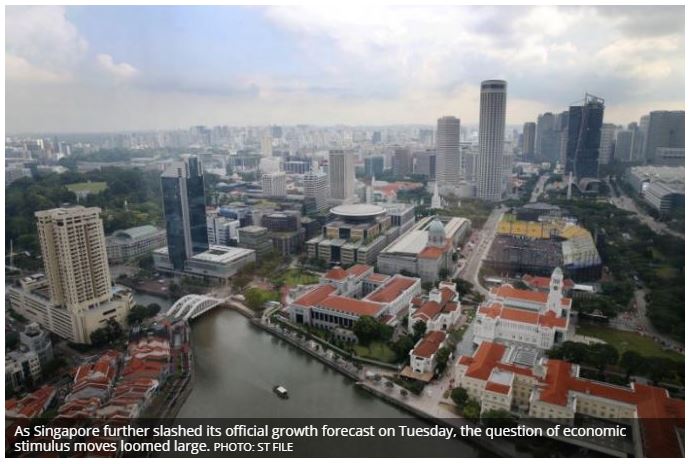Singapore: Growth downgrades, heightened risks and the stimulus question
AS Singapore further slashed its official growth forecast on Tuesday, the question of economic stimulus moves loomed large.
Not time yet, argued some. Targeted measures needed soon, said others. But where there is no disagreement is that it will be a challenging period for the Republic ahead.
Gross domestic product (GDP) is now expected to grow by between zero and 1 per cent this year – likely in the middle of that range – and it looks unlikely to get better from here.
Year-on-year expansion slowed sharply in the second quarter, to 0.1 per cent – easing from 1.1 per cent in the quarter before.
With the economy up by just 0.6 per cent altogether in the first six months, Ministry of Trade and Industry (MTI) economics division director Yong Yik Wei told a morning briefing that “we are basically looking at similar growth… in the second half”.
Meanwhile, GDP growth in many key final demand markets is not expected to improve in the second half either, the MTI added in a statement.
It cited risks such as worsening trade relations between the United States and China, and Japan and South Korea, and geopolitical tensions in North Korea and the Strait of Hormuz.
The glum outlook is a far cry from an initial prediction of growth of 1.5 per cent to 3.5 per cent, which was unceremoniously trimmed in May. On a seasonally adjusted, quarterly basis, GDP shrank by 3.3 per cent, after growing by 3.8 per cent in the first quarter. Two straight quarter-on-quarter declines would push Singapore into technical recession.
Minister for Trade and Industry Chan Chun Sing wrote on Facebook in the evening: “The Government will continue to monitor the situation closely because every economic cycle is different and we must apply the right measures in order to effectively support our businesses and workers.”
Deputy Prime Minister Heng Swee Keat, who is Finance Minister as well, had also said last month that help would be ready for businesses and workers here, should the global economy take a sudden turn for the worse.
Indeed, some private economists are already calling for the Republic to deploy the lifeboats, ahead of the next national Budget in February.
Selena Ling, head of treasury research and strategy at OCBC Bank, as well as Maybank Kim Eng economists Chua Hak Bin and Lee Ju Ye, are eyeing stimulus packages aimed at small businesses in manufacturing and other trade-related industries.
Singapore Business Federation chief executive Ho Meng Kit agreed that measures – if any are taken – should be targeted at ailing sectors.
“The key focus should be on helping viable companies stay afloat, keeping people in their jobs as well as helping workers who lose jobs find new ones through retraining with new skills,” he told The Business Times.
Meanwhile, various analysts cited the S$20.5 billion Resilience Package of 2009 as a model intervention, with Gerald Wong, head of Singapore research at Credit Suisse, highlighting its focus on employment subsidies and public infrastructure spending.
Other historical moves have included income and corporate tax cuts and rebates, noted United Overseas Bank economist Barnabas Gan. He added that bail-out packages would likely aim for tax relief and liquidity, as well as support company cash flows and the broader labour market.
Still, Mr Gan does not think that the ship is sinking just yet – and he has company. Some economists told BT that the Government should not act unless a full-blown recession or large-scale lay-offs start to happen.
“They are ready to step in if there is a sharp deterioration… if there is negative growth,” Credit Suisse’s Mr Wong observed.
“At this stage, monetary easing would be the first form of policy support, with next year’s Budget used to provide fiscal support if needed,” ANZ Asia research head Khoon Goh added. “The last time Singapore embarked on a large fiscal stimulus was during the global financial crisis, and we are not close to that situation at present.”
DBS senior economist Irvin Seah, who expects “more accommodative” monetary and fiscal policies, also believes that a stimulus package will come in the next Budget, rather than in the near term, as “the economy is not at risk of a full recession yet”.
He wrote in a report: “The Government can afford to keep its powder dry and be more calibrated on the policy front at the moment.”
The overall economy was dragged down in the second quarter by manufacturing, which widened its year-on-year decline to 3.1 per cent – from 0.3 per cent in the three months prior. The MTI expects weakness in electronics and precision engineering to stretch into the rest of the year, on poor global semiconductor demand, while chemicals manufacturing could soften on a slowdown in China.
Meanwhile, services growth slowed to 1.1 per cent, from 1.2 per cent before. The sector is expected to be supported by finance and insurance and information and communications, although Trade and Industry Permanent Secretary Gabriel Lim noted that the pockets of growth “are not as big as manufacturing, in terms of the share of (value added)”.
Otherwise, construction expanded by 2.9 per cent in the second quarter – up from 2.8 per cent before – and the MTI expects its recovery from last year’s contraction to be sustained.
Source: https://www.businesstimes.com.sg/government-economy/growth-downgrades-heightened-risks-and-the-stimulus-question


 Thailand
Thailand




